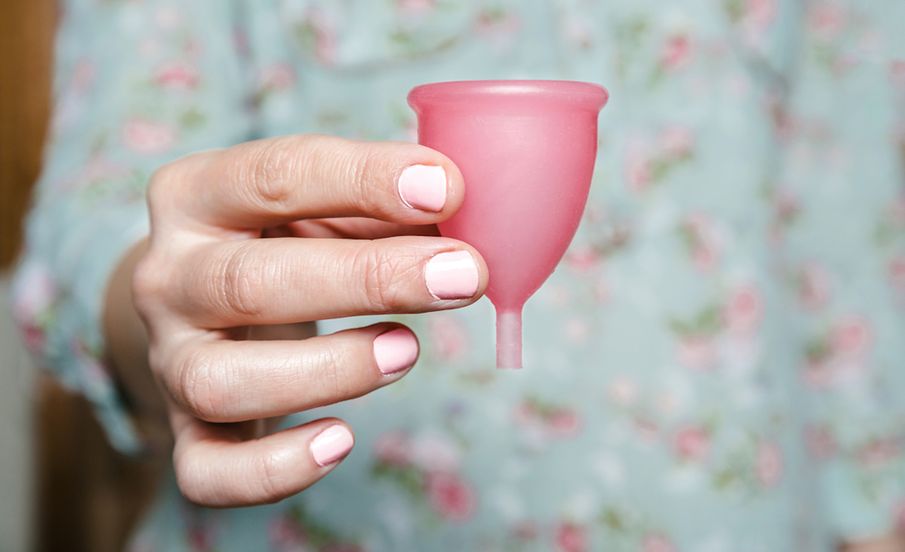A scientific review of menstrual cups has indicated that they are safe to use, as effective as other sanitary products and resulted in similar-to-less leakage than their disposable counterparts.
The majority (70%) of people who menstruate in the study who tried menstrual cups wanted to continue using them once they were familiar with how to use them. Practice, peer support and training are key to initiation, according to the report.
Although there are nearly 200 brands of menstrual cups, the report found awareness of them is low. The cups collect blood flow, rather than absorbing it as with pads and tampons. Like tampons, cups are inserted into the vagina, before being emptied every 4-12 hours. There are currently two types: a vaginal cup which is generally bell-shaped, and a cervical cup which is placed around the cervix high in the vagina like a diaphragm for contraception. The materials used to make them are medical grade silicone, rubber, latex or elastomer and can last up to 10 years, the report states.
For many menstruators, period products can be hard to access - if at all.
— The Cup Effect (@TheCupEffect) July 4, 2019
That’s why for each cup you buy from us two menstrual cups are donated. Because, together, we have the power to say goodbye to period poverty. Period.
Get yours: https://t.co/Pa7U0Vu7dz pic.twitter.com/Buo7NreXeE
“Despite the fact that 1.9 billion women globally are of menstruating age - spending on average 65 days a year dealing with menstrual blood flow, few good quality studies exist that compare sanitary products,” says senior study author Professor Penelope Phillips-Howard from the Liverpool School of Tropical Medicine, UK. “We aimed to address this by summarising current knowledge about leakage, safety, and acceptability of menstrual cups, comparing them to other products where possible.”
The study states that there was no increased risk of infection associated with using menstrual cups among European, North American, and African participants.
The study also showed that menstrual cups are more cost-effective than other options. Preliminary evidence on the cost and waste savings associated with using menstrual cups suggests that over 10 years, a single menstrual cup could cost much less than pads or tampons, according to the study.
Study authors identified 199 brands of cup being available in 99 countries, with a wide range of prices from $0.72 to $46.72. A cup could cost roughly 5% or 7% of the cost of using 12 pads (on average $0.31 each) or tampons (on average $0.21 each) per period.
Everyone with periods, seriously invest in a menstrual cup or another form of reusable product if you can. We produce so much waste with tampons/pads/liners/packaging (220 tons per year, mostly plastic which ends up in landfills) when there are so many other amazing options! pic.twitter.com/tcPEk12bMT
— christina (@steeniston) July 15, 2019
Plastic waste might also be reduced. Over 10 years, a cup is estimated to create 0.4% of the plastic waste generated by single-use pads or 6% of that produced by using tampons. The authors note that the cost and waste estimates are only illustrative, and do not account for the combined use of menstrual products, inflation, or production costs.
Happiful spoke with Mandu Reid of The Cup Effect, a charitable social enterprise and advocacy organisation, about the report. “In common with other members of the Menstrual Cup Coalition, I have found that lack of knowledge and misconceptions about menstrual cups prevent international NGOs and governments from including cups in their menstrual health programming, typically offering only disposable or cloth pads. Common misconceptions include: the idea that cups are difficult, uncomfortable and inconvenient to use; belief that cultural attitudes linked to notions of virginity, body-shame, or disgust create insurmountable barriers to menstrual cup acceptance; and that in poor, water-scarce communities, using menstrual cups is likely to lead to infections.
“This study is a huge step forward and will help to validate the work of several members of the Menstrual Cup Coalition that have trained and distributed menstrual cups to over 100,000 women and girls across several countries. This study will also encourage organisations and governments across the world to include menstrual cups in their programming in order to allow more people to make a truly informed choice about their use.
“A unique feature of our work is that we sell menstrual cups to people in affluent countries and for every cup sold, two are donated to women and girls from low income communities. So far, we have initiated projects that have reached over 5,000 women and girls – meaning a whole decade of reduced hassle, more comfortable, expense free, and environmentally friendly period for each cup recipient. Supporting our work is an easy way to make a big difference that has an enduring impact.”
If you’re interested in purchasing a menstrual cup, consider buying one that helps a good cause. Your purchase can help other menstruators in need.
Notes from the study: The studies and analysis are the first systematic review and meta-analysis of the international use of menstrual cups, which included 43 studies and data from 3,300 women and girls and is published in The Lancet Public Health journal. The studies were funded by the UK Medical Research Council, the Department for International Development and the Wellcome Trust through their Joint Global Health Trials scheme. They were conducted by researchers from the Liverpool School of Tropical Medicine, the Tata Institute of Social Sciences, the Kenya Medical Research Institute, Edinburgh Royal Infirmary and the Bill & Melinda Gates Foundation.


Comments